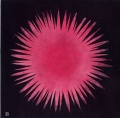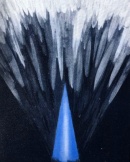Thought-Forms
The phrase of Thought-Forms was developed by Annie Besant and C. W. Leadbeater in their 1905 book Thought Forms, although the concept was present in earlier Theosophical literature, including The Mahatma Letters to A. P. Sinnett
Thought-Forms in the Mahatma Letters
In one of his letters to A. P. Sinnett, Mahatma K. H. writes:
Thoughts are things — have tenacity, coherence, and life, — that they are real entities.[1]
This concept is further developed by the Master in a letter to A. O. Hume:
Every thought of man upon being evolved passes into the inner world and becomes an active entity by associating itself — coalescing, we might term it — with an elemental; that is to say with one of the semi-intelligent forces of the kingdoms. It survives as an active intelligence, a creature of the mind's begetting, for a longer or shorter period proportionate with the original intensity of the cerebral action which generated it. Thus, a good thought is perpetuated as an active beneficent power; an evil one as a maleficent demon. And so man is continually peopling his current in space with a world of his own, crowded with the offsprings of his fancies, desires, impulses, and passions, a current which reacts upon any sensitive or and nervous organisation which comes in contact with it in proportion to its dynamic intensity.[2]
Thought forms as described by Besant and Leadbeater
Annie Besant and C. W. Leadbeater, the authors of Thought-Forms, wrote that "each definite thought produces a double effect — a radiating vibration and a floating form." The radiating vibration "conveys the character of the thought, but not its subject." For example, serenity or devotion radiating from one person can stimulate similar vibrations in a nearby person who is receptive. The floating form is a strong and definite thought that has attracted energies from the mental and astral plans, and has become, for a time, a kind of independent living being.
Thought-forms directed towards individuals produce definitely marked effects... A thought of love and of desire to protect, directed strongly towards some beloved object, creates a form which goes to the person thought of, and remains in his aura as a shielding and protecting agent; it will seek all opportunities to serve, and all opportunities to defend, not by a conscious and deliberate action, but by a blind following out of the impulse impressed upon it, and it will strengthen friendly forces that impinge on the aura and weaken unfriendly ones. Thus may we create and maintain veritable guardian angels round those we love...
In cases in which good or evil thoughts are projected at individuals, those thoughts, if they are to directly fulfil their mission, must find, in the aura of the object to whom they are sent, materials capable of responding sympathetically to their vibrations. Any combination of matter can only vibrate within certain definite limits, and if the thought-form be outside all the limits within which the aura is capable of vibrating, it cannot affect that aura at all. It consequently rebounds from it, and that with a force proportionate to the energy with which it impinged upon it.[3]
They identified three classes of thought forms:
- 1. That which takes the image of the thinker.
- 2. That which takes the image of some material object.
- 3. That which takes a form entirely its own, expressing its inherent qualities in the matter which it draws round it. Only thought-forms of this third class can usefully be illustrated.
These are some examples using illustrations from the book Thought-Forms:
Tulpa in Tibetan Buddhism
Tibetan Buddhism offers the concept of "tulpa" as an apparition or object created by the power of the mind. Walter Evans-Wentz used the term "thoughtform" in his translation of the Tibetan Book of the Dead.
French explorer and Theosophist Alexandra David-Néel wrote of tulpas as "magic formations generated by a powerful concentration of thought."[4] She further wrote that
The power of producing magic formations, tulkus or less lasting and materialized tulpas, does not, however, belong exclusively to such mystic exalted beings [Bodhisattvas]. Any human, divine or demoniac being may be possessed of it. The only difference comes from the degree of power, and this depends on the strength of the concentration and the quality of the mind itself.”[5]
Alice Bailey on thought-form building
Alice Bailey wrote about the building of thought forms.
In the works of Alice Bailey, the process of creating a concept, or "building a thought-form" is viewed as a deeply esoteric magical act*. We are, quite literally, talking about the construction of a form in the subtle matter of the mental plane. This form can then take an emotional body, and an etheric body, and go on to produce an impact in the three worlds of human evolution...
- The fifteen rules for thought-form building form the basis for the book "A Treatise on White Magic" and are also discussed more briefly in "A Treatise on Cosmic Fire".[6]
Other descriptions
Author Gus diZerega wrote,
I have tried to make the case that ideas are more important than we usually acknowledge. They are more than just fleeting flights of subjectivity that pass through our minds and are gone. Thought forms are ideas on steroids.
They are also our creations, though I suspect they have other sources as well.
Thought forms are dependent on the people who generate the mental energy empowering them. Good or bad, they are expressions of human creativity. Take away our energy and focus, and they weaken. Some are positive influences in our lives, and their relationship with us is symbiotic. Others are negative, and the relationship is parasitic because they depend on our anger and fear for their power; anger and fear ultimately weaken us mentally, physically, and spiritually. [7]
According to Bulgarian philosopher Omraam Mikhaël Aïvanhov:
If there is one thing that is important for you to know, it is that every thought, even the most insignificant, is a living reality. Thoughts can even be seen, there are people who can see them. Of course on the physical plane, a thought is invisible and intangible, but it is no less real: in its own region and with its own subtle matter, it is a living, active being.[8]
Rachel Goodwin adds,
Thoughtforms can be described as energetic patterns that exist within our aura, and they are created by our own thoughts. So if you have the thought, "I have all the energy I need, I have all the energy I need," with enough conviction and belief, you'll create a thought form who makes this so, and this newly created thoughtform will then live happily inside your aura.
This thoughtform will help you draw towards you all the circumstances you need to make it so...
You could say that thoughtforms are the spiritual equivalent to computer programs, and sub-routines, as they will keep running the same programme until the time where an intent and focus is made (by you) to change them.[9]
Use of the term in popular culture
Thought Forms is also the name of a 3-piece band from Wiltshire, England, with albums released on Invada Records. An illustration from the book (Figure 17, Response to Devotion) appears on their website.[10]
“Thought Forms” is a set of three musical compositions on the album Cult Appeal by the Horse Lords on the Chicago label Hausu Mountain.[11]
"Thought Forms" is also the name of a poem by Judy Sevens.[12]
In the television program X-Files, the episode "Home Again" mentions the Tibetan Buddhist concept of tulpa and the Theosophists' concept of thought forms. [13]
Additional resources
Articles
- Thought Forms at Theosopedia.
- Thought-Forms (Their Limitations) by Hugh Shearman.
- Thought Forms by Samuel Hatfield.
- Alderdon, Zoe. "Colour, Shape, the Music: The Presence of Thought Forms in Abstact Art" Literature & Aesthetics 21.1 (June 2011), 236.
Books
- Thought Forms by Annie Besant and C. W. Leadbeater
- Thought Power - Its Control and Culture by Annie Besant
Notes
- ↑ Vicente Hao Chin, Jr., The Mahatma Letters to A.P. Sinnett in chronological sequence No. 18 (Quezon City: Theosophical Publishing House, 1993), 66.
- ↑ Vicente Hao Chin, Jr., The Mahatma Letters to A.P. Sinnett in chronological sequence Appendix I (Quezon City: Theosophical Publishing House, 1993), 472.
- ↑ Annie Besant; C. W. Leadbeater, Thought-Forms (London, Benares: Theosophical Publishing Society, 1905)p???.
- ↑ Quoted in Eileen Brennan; J. H. Underwood, Body Mind & Spirit: A Dictionary of New Age Ideas, People, Places, and Terms (New York: Tuttle, 1994), ??.
- ↑ Alexandra David-Néel, Magic and Mystery in Tibet, 1929, pg 115.
- ↑ "Esoteric Aspects of Thought-Form Building," Lucis Trust website.
- ↑ Gus diZerega, "If Thought Forms Exist, What Can We Do About Them?" February 7, 2013. Pointedly Pagan blog on Pagan Channel. Accessed January 13, 2016.
- ↑ Rachel Goodwin, "The Power of Thoughtforms," at Trans4Mind website. Accessed January 13, 2016.
- ↑ Rachel Goodwin, "The Power of Thoughtforms," at Trans4Mind website. Accessed January 13, 2016.
- ↑ "Our Favourite Records of 2015." Weblog entry dated December 31, 2015. Located at this website. Accessed January 13, 2016.
- ↑ Colin Joyce, " Andrew Bernstein Does Damage to Sax Structures on ‘Thought Forms’". “Thought Forms” spin.com. Accessed January 13, 2016.
- ↑ Judy Sevens, "Thought Forms" blog entry. November 21, 2014. Available at Blogspot. Accessed January 13, 2016.
- ↑ Jeff Jensen. "The X-Files Recap: Home Again". Entertainment Weekly website. See X-Files Season 10, episode 4 "Home Again" that first aired February 8, 2016.











